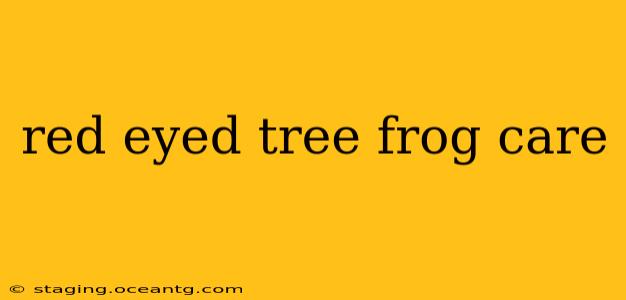The vibrant red eyes of the red-eyed tree frog (Agalychnis callidryas) are captivating, making them a popular choice for both experienced and aspiring herpetologists. However, providing proper red-eyed tree frog care requires dedication and a deep understanding of their specific needs. This comprehensive guide delves into the essential aspects of keeping these fascinating amphibians healthy and happy in captivity.
What Do Red-Eyed Tree Frogs Eat?
Red-eyed tree frogs are primarily insectivores. Their diet in the wild consists of crickets, grasshoppers, moths, and other small insects. In captivity, you should offer a varied diet to ensure they receive all the necessary nutrients. Gut-loading your insects with nutritious foods like carrots, leafy greens, and high-quality cricket food is crucial. This ensures the frogs ingest the vitamins and minerals they need to thrive. Avoid feeding them insects captured from the wild, as these could contain pesticides or parasites.
How Big Do Red-Eyed Tree Frogs Get?
Adult red-eyed tree frogs typically reach a size of 2-3 inches (5-7.5 cm) in length from snout to vent. Males are generally smaller than females. Their size, combined with their arboreal nature, means they don't require excessively large enclosures.
How Long Do Red-Eyed Tree Frogs Live?
With proper care, red-eyed tree frogs can live for 5-10 years in captivity. However, providing a suitable environment, a diverse diet, and regular monitoring for disease are crucial to maximizing their lifespan. Factors like stress and poor husbandry can significantly reduce their longevity.
What Size Enclosure Do Red-Eyed Tree Frogs Need?
The enclosure size depends on the number of frogs you house. For a single adult, a 10-gallon tank is generally sufficient, while a pair would benefit from a larger 20-gallon long tank. Vertical space is essential, as these frogs are arboreal and spend most of their time in the branches and foliage. A taller enclosure is far more suitable than a wide, shallow one.
What Kind of Substrate Should I Use for Red-Eyed Tree Frogs?
The substrate should retain moisture but not be constantly soggy. A good option is a mix of coco fiber and sphagnum moss. This provides excellent drainage and helps maintain the appropriate humidity levels. Avoid using materials that can become moldy easily. Always ensure the substrate is cleaned regularly to prevent the build-up of waste and bacteria.
How Often Should I Mist My Red-Eyed Tree Frog's Enclosure?
Maintaining appropriate humidity is critical for red-eyed tree frog health. You should mist the enclosure several times a day, aiming for a humidity level between 60-80%. A hygrometer is essential to monitor the humidity and ensure it remains within the ideal range. Over-misting can lead to mold and bacterial growth, while under-misting can cause dehydration.
What Temperature Should the Enclosure Be?
Red-eyed tree frogs thrive in warmer temperatures. The ideal temperature range is 72-78°F (22-26°C) during the day, with a slight drop at night. A heat mat placed on one side of the enclosure allows the frog to thermoregulate by moving to warmer or cooler areas. Avoid using heat rocks, as they can cause burns.
What Plants Are Safe for Red-Eyed Tree Frogs?
Providing ample foliage is crucial for their well-being. Live plants not only enhance the aesthetic appeal but also provide hiding places and enrichment. Suitable options include bromeliads, orchids, and pothos, all of which are relatively low-maintenance. Ensure all plants are pesticide-free.
How Do I Handle My Red-Eyed Tree Frog?
Handling red-eyed tree frogs should be kept to a minimum. They are delicate creatures, and excessive handling can cause stress and injury. If handling is absolutely necessary, wash your hands thoroughly before and after to avoid transferring harmful bacteria or chemicals.
Are Red-Eyed Tree Frogs Good Pets for Beginners?
While captivating, red-eyed tree frogs are not ideal pets for absolute beginners. Their specific environmental requirements and dietary needs demand commitment and careful observation. Research and thorough understanding are key to their successful keeping. Beginners might find easier-to-care-for species a better starting point before taking on these arboreal beauties.
This guide provides a foundation for successful red-eyed tree frog care. Remember that continuous learning and observation are essential to ensure the health and well-being of these fascinating amphibians. Consult reputable sources and experienced keepers for further information and support.
